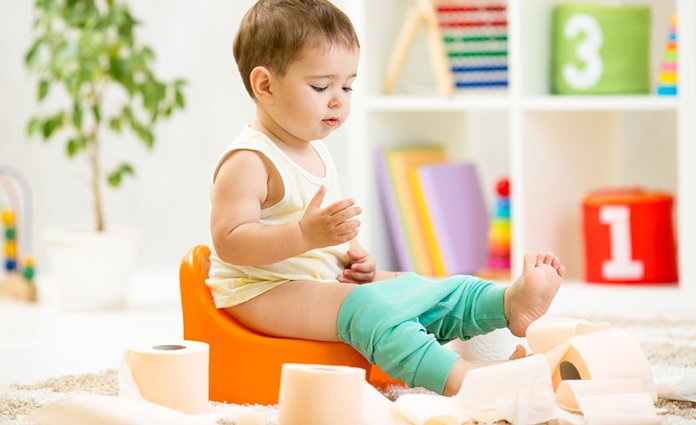Your baby's stool

Stools say a lot about our health. This also applies to your baby, because your baby's stool can also have different colors and shapes. But what is actually normal? Don't look away from the diaper, look at the stool to learn more about your baby's development and health.
Dark green stool baby
Especially in the first year of your baby you will see many different types of stools. It can differ in smell and color, as well as in consistency. The stool can be from dark green to black in color.
During the first days after the birth of your baby, it is quite normal for your baby's stools to look green and consist of a sticky substance. This is because your baby is pooping meconium, which is the 'food' that your baby has had in the amniotic fluid in your womb. After about two days, the stool becomes softer and yellow when breastfeeding. If your baby has eaten green leafy vegetables or is teething, the stool may also turn dark green.
Red/orange stool baby
If you find red streaks in your baby's stool, this usually indicates blood in the stool. The cause can be a small tear at the anus, but it can also arise if you suffer from cracked nipples due to breast-feeding. However, red stools can also indicate a serious problem. Your baby may have an allergy, bacterial infection, or bleeding in his GI tract.
An innocent cause for red stools is red cabbage/beetroot on his menu. However, was this not the case or is the stool a different color? Then it is wise to consult a doctor.
Black stool baby
Black stools (which are no longer meconium) occur when blood enters the intestines. It usually means that there is bleeding somewhere in the gastrointestinal tract. During the journey through the gastrointestinal tract, this blood changes color from red to black.
Sometimes iron supplements or iron in food can also color stools dark brown or black. Then nothing is wrong. Isn't this the probable cause? Then it is best to go to your doctor.
Difference in nutrition
What your baby's stools look like depends, among other things, on the choice of food. When breastfeeding, the stool looks different than when you bottle-feed. We recommend that you breastfeed until your baby is at least 6 months old.
The stool of a breastfed baby has a clear yellow to mustard yellow color. The structure is looser than in the stool of a baby that is bottle-fed. In addition, the smell is also more pleasant when breastfeeding, it can have a sweet smell.
Breastfeeding is easier to digest than bottle feeding, so the poop of bottle-fed babies is more solid and they often poop once a day. For breastfed babies, it can range from four times a day to once every few days. Both numbers are considered healthy and normal, as long as the poop is soft and comes out easily.
In the beginning, a breastfed baby will often poop after feeding. Eventually, this will become more and more regular and your child will defecate more often at fixed times.
Stool baby of one year and older
The stools will change after your baby turns one year and starts eating more and more solid food. Your baby needs to get used to this new food. It is therefore important to keep a close eye on your baby's stools during this transition. When your child has turned 2, the stomach and intestinal tract are completely used to solid food. This means that your baby's stools then look like a sausage with indigestible pieces.
When your baby is in this phase, you are in the phase with the stinky diapers. The poop now naturally consists of solid food, which means that the stool consists of larger turds with more stench than you are used to.
Even though it is not always pleasant to do, it is important to keep an eye on your child's stool. This way you will learn more about the health and development of your child. Also remember that it is normal for stool consistency, color and/or frequency to change after giving solid food or after a change of formula.
Kabrita goat milk bottle feeding
Did you know that more goat's milk is drunk worldwide than cow's milk? In the Netherlands it is certainly different! Kabrita bottle feeding is a standard bottle feeding, based on goat's milk. Goat's milk is naturally mild and forms a good basis for bottle feeding. Kabrita follow-on milk and Toddler milk combine the mildness of Dutch goat milk with valuable ingredients such as DHA Omega-3 fatty acids* and GOS dietary fibre. That makes Kabrita a suitable choice for babies and toddlers.
Are you curious about our baby food based on goat's milk? Go to our webshop and order directly online!



